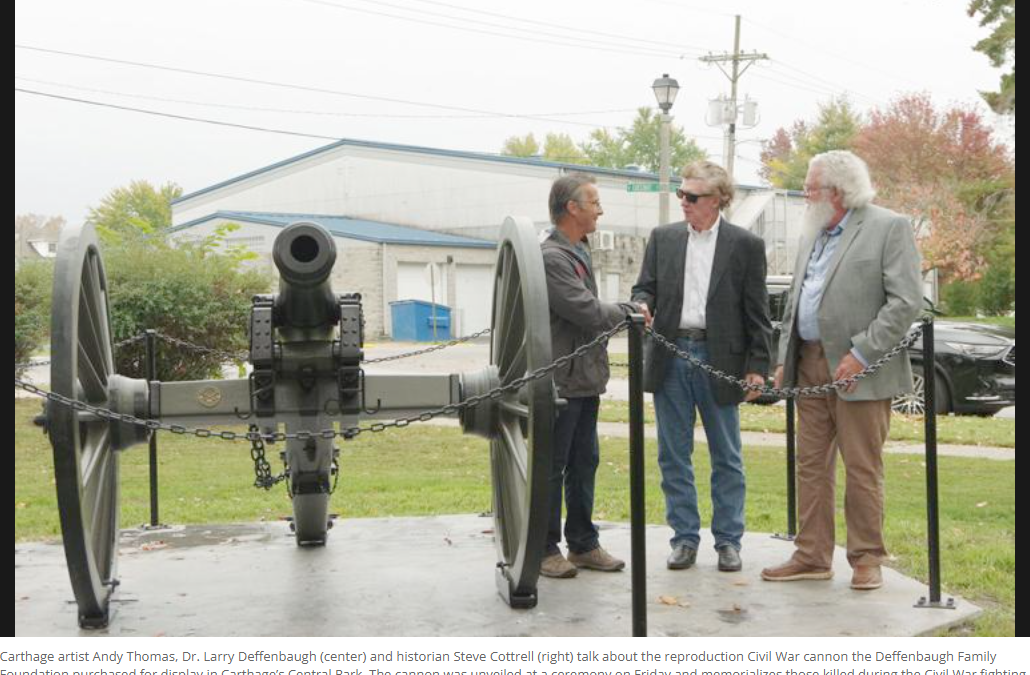MISSOURI: Carthga Unveils New Civil War Canon
CARTHAGE, Mo. — A new monument to the American Civil War and the hardship it caused in Carthage and Jasper County was dedicated Friday afternoon in Carthage’s Central Park.
Dozens of residents and city officials gathered in the drizzle to dedicate a replica Model 1841 six-pounder field artillery piece as a memorial to the soldiers who fought and died at the July 5, 1861, Battle of Carthage and to those area residents who endured the four years of hardships brought on by the war.
The Deffenbaugh Trust, a charitable trust created by Dr. Larry Deffenbaugh and his family, paid more than $35,000 to have the cannon and its metal carriage and wheels created at a foundry in Pennsylvania and shipped to Carthage.
The cannon was placed Friday morning on a concrete pad near the southeastern entrance to Central Park.
Historian Steve Cottrell said signs will be added soon to describe the cannon and the Battle of Carthage and Civil War history it commemorates.
“I think I speak for everyone when I say thank you Dr. Larry for your generous gift to Carthage, Jasper County and this entire region,” Cottrell said. “It’s weatherproof metal constructions ensures it will still be here long past our lifetime and will still be standing here 200 or 300 years from now.”
Living with history
Deffenbaugh said he’s been interested in the Civil War history of Jasper County since buying his farm north of Carthage, then finding out that part of his land was also part of the Battle of Carthage battlefield.
The battle was the first major land battle of the Civil War, taking place July 5, 1861, and pitting 1,100 U.S. soldiers under Col. Franz Sigel against about 6,000 relatively untrained members of the Missouri State Guard who were fleeing a larger Union Army.
The Missouri State Guard, commanded by Missouri Gov. Claiborne Fox Jackson, was heading for Arkansas to join the Confederate army.
Sigel’s troops were supposed to work with Union Gen. Nathaniel Lyon’s larger army coming from the north but Lyon’s force was delayed, leaving Sigel’s soldiers outnumbered.
Union troops camped overnight on July 4, 1861, around the spring in the Battle of Carthage State Historic Site on East Chestnut Street.
They marched north early on July 5 and met the Missouri State Guard on the hill near the current intersection of Civil War Road and Baseline Road.
Realizing he was outnumbered 4 to 1, Sigel led the Union troops on a fighting retreat south back into Carthage and beyond.
They paused at the creeks along their retreat to hold off the State Guard forces and allow their wagon train of supplies to get across the waterways.
Ornduff’s Hill, on Deffenbaugh’s farm, was the site of one of those stands.
“When I moved to Carthage and bought a farm, I found that it was on the border of the Battle of Carthage battlefield and there are markers at the top of the hill where we live, which is called Ornduff’s Hill,” Deffenbaugh said. “That was where Siegel made his stand as he was retreating across Spring River to delay the Missouri State Guard troops. So a neighbor of mine, Tom Bayless, is big into metal detecting and he’s helped me and we’ve found a number of expended bullets on Ornduff’s Hill. That’s really gotten me more interested in the history.”
Hallowed ground
Deffenbaugh said Central Park was the perfect place for the cannon because the park was an early Carthage cemetery.
“We’re on sacred ground where we stand right now,” Deffenbaugh said. “This is where the dead from the Battle of Carthage were first interred. It was also where a number of the original residents of the city were interred.
“Then in February of 1868, the federal government passed a bill with an appropriations component to build national cemeteries and in about 1870 they started to come back to the families if they could find them and see if they would be interested in moving the remains of these individuals to national cemeteries. Later the city fathers decided to move the entire cemetery, but not everyone wanted the remains disturbed and they couldn’t find some individuals. So within the boundaries of Central Park, we have individuals who remain here today, so this seemed to be the proper place.”
–joplinglobe.com



